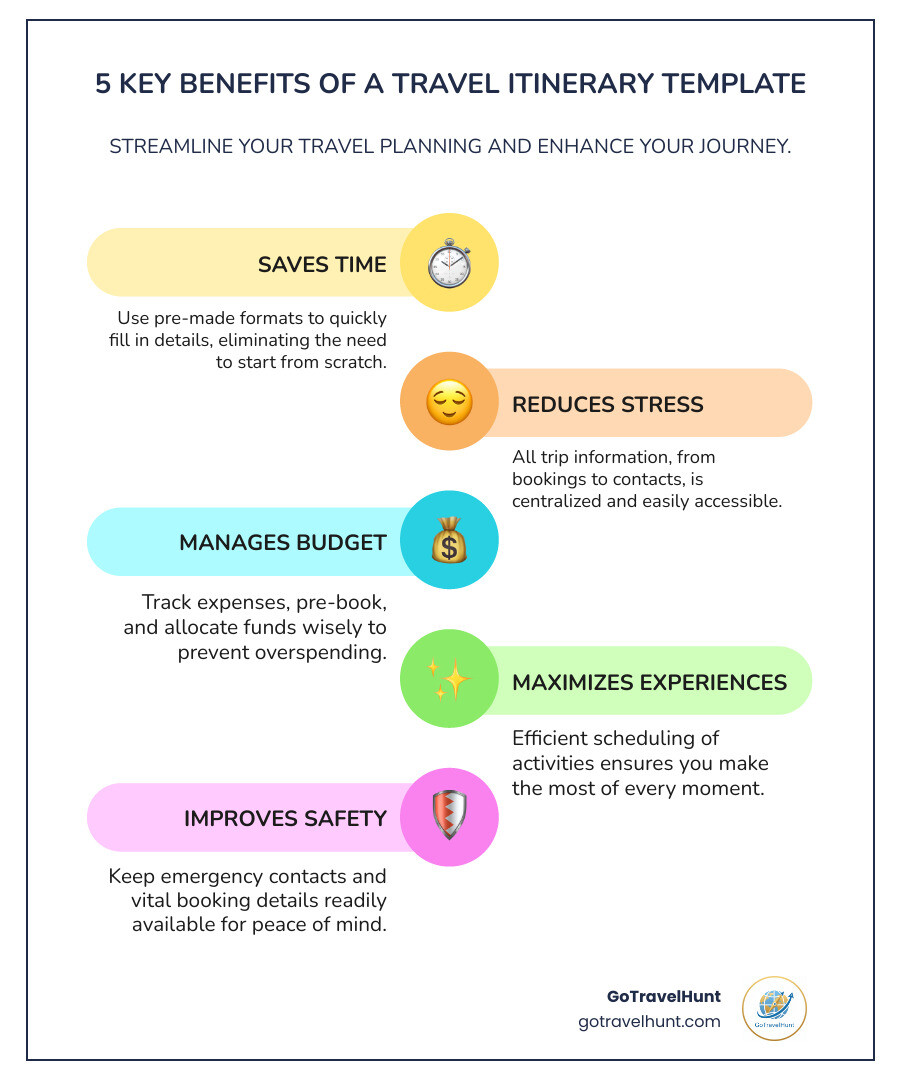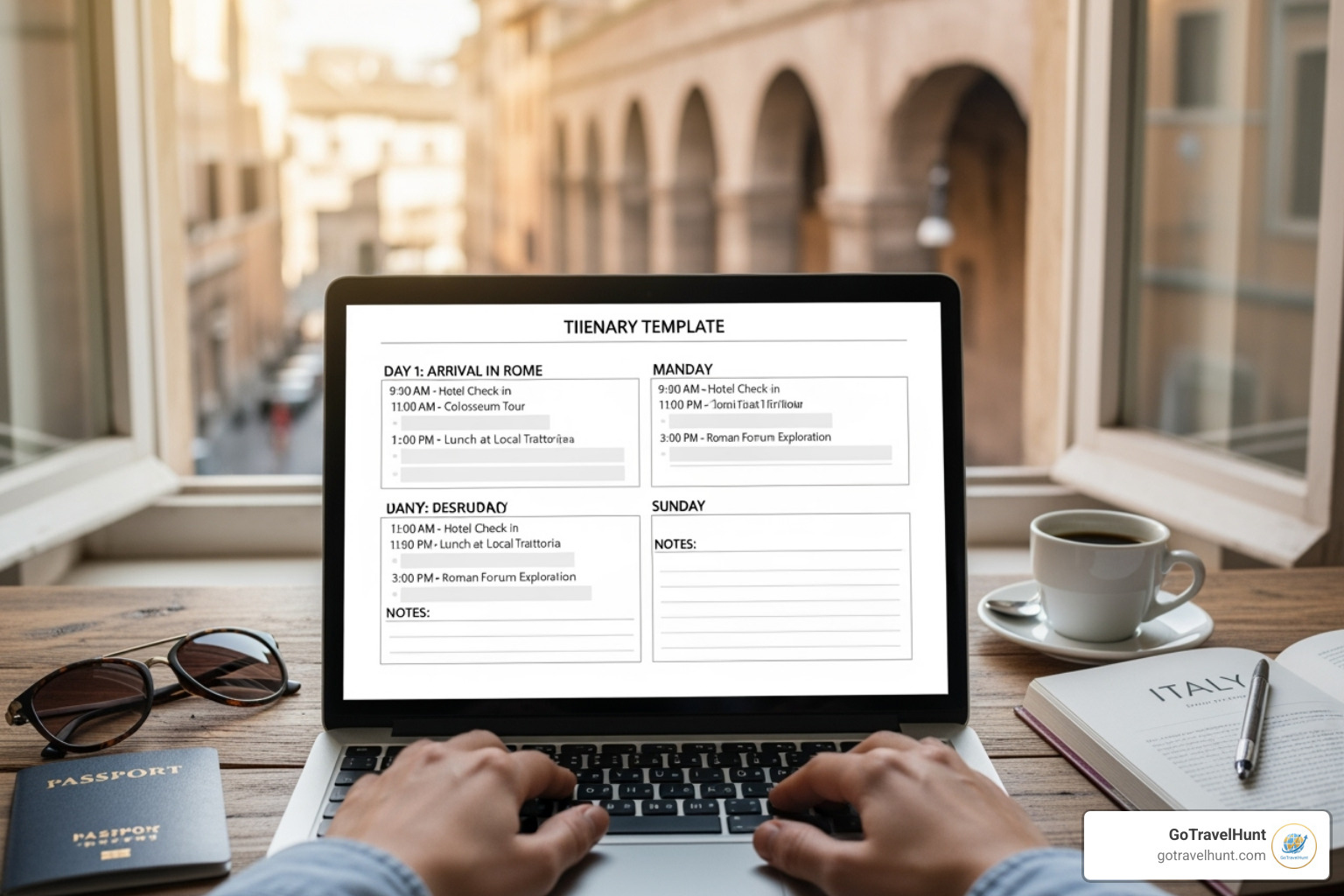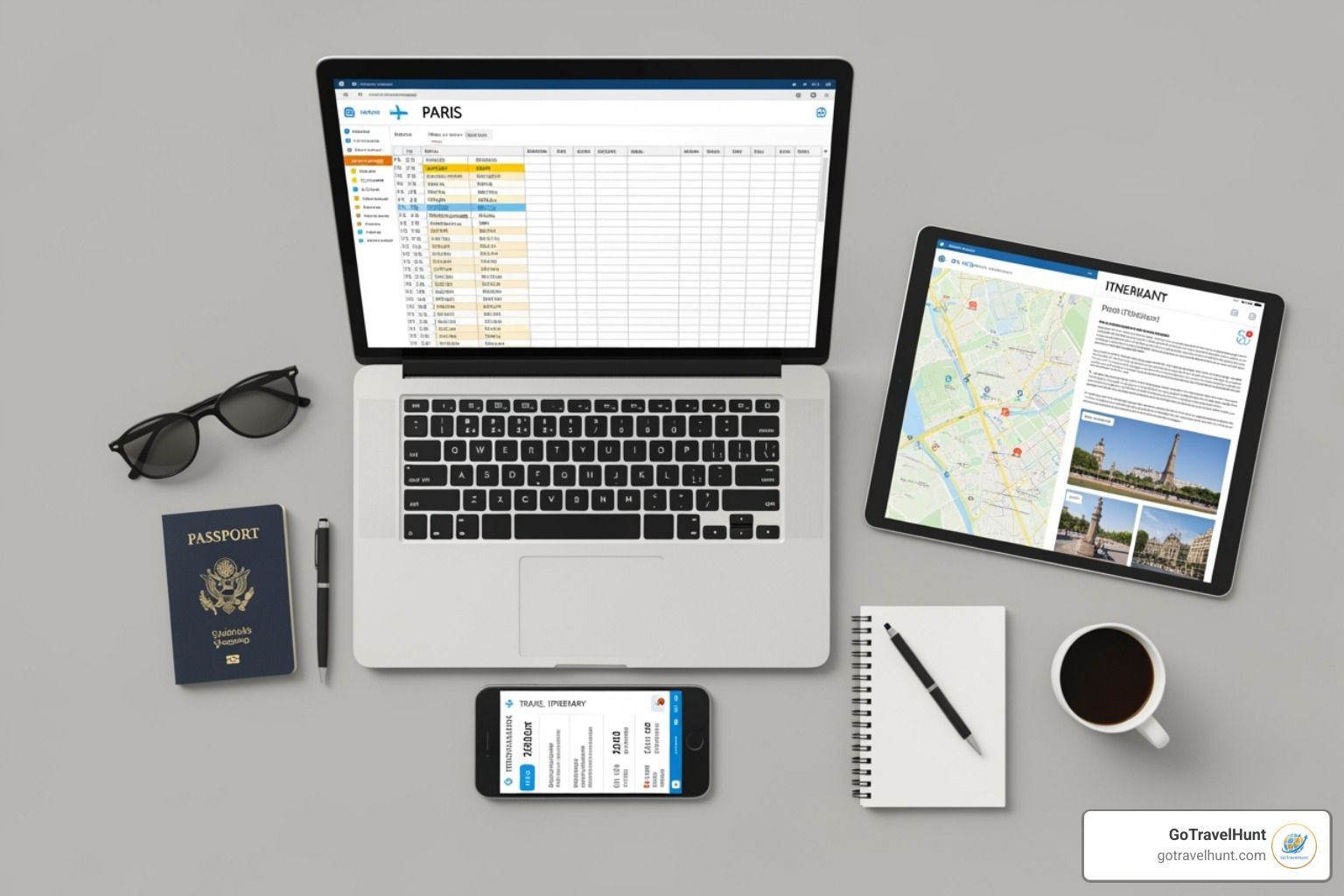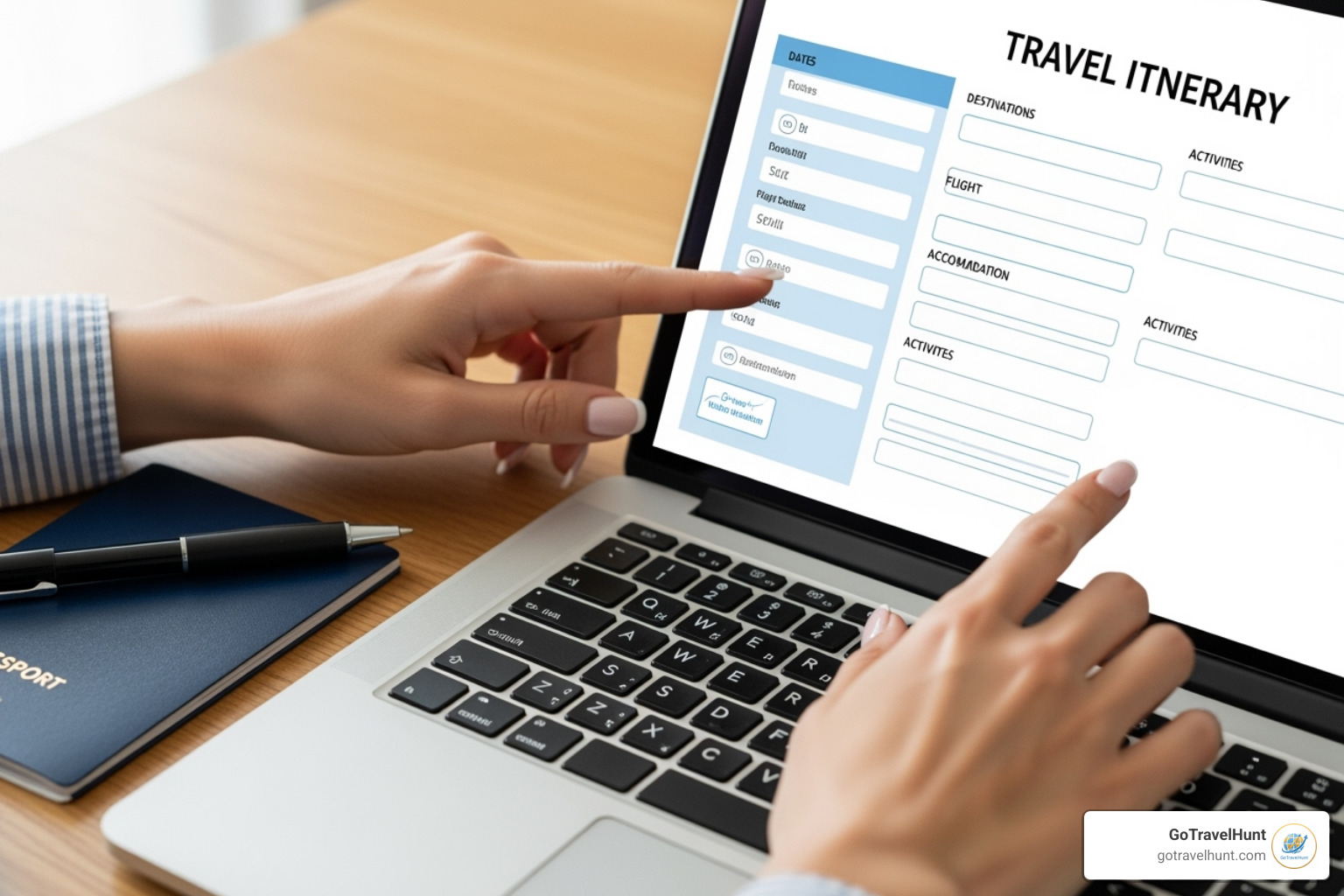Travel Itinerary Template: Your 5-Step Stress-Free Guide
Why Every Traveler Needs a Travel Itinerary Template
A travel itinerary template is a pre-formatted document that helps you organize all your trip details in one place-from flights and hotels to daily activities and emergency contacts. Here’s what you need to know:
Quick Answer: What is a Travel Itinerary Template?
- Definition: A ready-made framework for organizing your travel plans
- Purpose: Keeps all booking confirmations, schedules, and contact info centralized
- Formats: Available in Excel, Word, PDF, Google Docs, and Canva
- Benefits: Saves time, reduces stress, helps with budgeting, and ensures nothing gets forgotten
- Best For: Personal trips, family vacations, business travel, group tours, and visa applications
Planning a trip should be exciting, not overwhelming. A template prevents the stress of juggling scattered booking confirmations and unclear schedules. Instead of starting from scratch, you fill in pre-made fields, saving time for your adventure.
Whether you’re planning a weekend getaway or a month-long international journey, the right template transforms chaotic planning into an organized roadmap. It helps you track expenses, allocate time wisely, and ensure you never miss a flight or lose a confirmation number. Platforms like Canva and Template.net offer thousands of free, downloadable options to get you started.
I’m Ramy Saber, founder of GoTravelHunt, and I’ve seen how a well-structured travel itinerary template transforms anxious planners into confident explorers by providing practical, stress-free resources.

What is a Travel Itinerary and Why is it Essential?
A travel itinerary is your trip’s roadmap, a detailed document that organizes every aspect of your journey in one convenient place. It’s a chronological breakdown of your adventure, including flight times, hotel addresses, transportation plans, daily activities, dining reservations, and important confirmation numbers.
Think of it as your travel command center. Everything you need to know lives in this single document, eliminating the need to dig through emails for booking details. A well-crafted itinerary transforms travel from chaotic to calm, bringing organization and confidence to your trip. It acts as a powerful stress reduction, time management, and budgeting tool, leading to an improved travel experience from start to finish. For example, having a clear plan is crucial when Traveling with Family to keep everyone happy and coordinated.

Key Benefits of a Well-Planned Itinerary
A well-planned itinerary is transformative, replacing travel anxiety with confidence. Here are the key advantages:
- Saves Time: With all logistics organized, you spend less time searching for confirmations and more time enjoying your destination.
- Reduces Stress: Knowing what comes next eliminates uncertainty and allows you to relax and immerse yourself in the experience.
- Manages Budget: By mapping out expenses in advance, you can make informed spending decisions and avoid going over budget, which is perfect for planning Cheap Weekend Getaway Destinations.
- Maximizes Experiences: Thoughtful scheduling helps you fit in more of what you love without feeling rushed, ensuring you don’t miss any must-see attractions.
- Improves Safety: Having emergency contacts, hotel addresses, and flight details in one place is crucial if something unexpected happens. This is especially important for solo travelers.
How an Itinerary Helps with Budgeting and Time Management
Your travel itinerary template serves as both a financial planner and a time optimizer. By listing all anticipated costs-flights, lodging, activities, and meals-you get a complete financial picture of your trip. This foresight allows you to take advantage of pre-booking savings on hotels and tours, which can significantly reduce your overall cost. This makes trips like Inexpensive Vacations for Couples more achievable.
For time management, you allocate time blocks for each activity, including realistic travel time between locations. Many travelers underestimate the time needed to get from point A to B. Factoring in transit prevents the stress of rushing and helps you build a balanced schedule with enough downtime to avoid exhaustion. This efficient scheduling ensures you see everything on your list without feeling overwhelmed.
The Anatomy of a Perfect Itinerary
An effective itinerary is a clearly organized document that puts all essential information at your fingertips. The goal is to create a single source of truth for your trip, so you’re not digging through emails for a confirmation number at the last minute.

Core Components to Include
To build a stress-free trip, your travel itinerary template should include these core components:
- Flight Information: Airline, flight numbers, departure/arrival times (in local time zones), terminals, and confirmation numbers.
- Accommodation Details: Property name, full address, check-in/out dates, reservation numbers, and contact information.
- Transportation Plans: For car rentals, trains, or buses, include the company, booking reference, schedules, and pickup/drop-off details.
- Daily Activities and Sightseeing: An outline for each day with locations, times, and confirmation numbers for any pre-booked tours. Leave some room for spontaneity!
- Dining Reservations: Restaurant name, reservation time, and confirmation details.
- Confirmation Numbers: A centralized list for all bookings (flights, hotels, tours, etc.) for easy reference.
- Emergency Contacts: Local emergency numbers (police, ambulance), your embassy’s contact info, your travel insurance helpline, and personal contacts back home.
- Important Notes: A space for reminders like currency information, local customs, or a link to a resource like our Best Travel Packing List.
Information for Special Cases: Visa Applications
For many visa applications, a detailed itinerary is a mandatory requirement. It serves as proof of your travel intent, showing officials you have a legitimate, well-planned reason for visiting and intend to return home. Your visa itinerary must include:
- Detailed Daily Plan: Outline your intended activities and locations for each day of your trip.
- Hotel Booking Proof: Provide confirmation for accommodation for every night of your stay, including the hotel’s name, address, and reservation number.
- Flight Reservations: Show confirmed arrival and departure flights to demonstrate your intent to leave the country within the visa’s validity period.
- Contact Information: Include phone numbers and addresses for hotels or hosts at your destination.
A specialized template can simplify this. You can find resources like a Free Visa Application Itinerary Template to Edit Online designed to meet these specific requirements.
Choosing and Using Your Travel Itinerary Template
Finding the perfect travel itinerary template is like choosing the right suitcase-it needs to match your journey’s style and complexity. Whether you’re a solo explorer or coordinating a large group, there’s a template for you.
| Template Type | Key Features |
|---|---|
| Solo Travel | Daily schedule, contact info, emergency contacts, travel details. Allows for detailed planning while providing flexibility. |
| Family Vacation | Multi-person daily schedules, booking details, specific activity times, emergency contacts, medical info for each family member. Space for notes on kid-friendly activities or special needs. |
| Business Trip | Meeting schedules, flight/hotel info, client contact details, expense tracking sections, specific meeting locations and times. Often more rigid but needs adaptability for unexpected changes. |
| Group Travel | Shared document access, individual daily schedules, group activities, shared expenses, emergency contacts for all members. Emphasizes coordination. |
| Romantic Getaway | Focus on experiences, dining reservations, leisure time, special notes for surprises or preferences. Less about minute-by-minute scheduling, more about mood and flow. |
| Adventure Travel | Detailed gear lists, safety information, emergency contacts, specific route details, weather considerations, backup plans. Focus on preparation and safety. |
Finding the Right Travel Itinerary Template for Your Trip
With thousands of free templates available on platforms like Canva, you can find the perfect format (Word, Excel, PDF) for your planning style.
- Personal and Solo Trips: Simple, streamlined templates work best, keeping safety info for Solo Travel Destinations front and center while allowing for spontaneity.
- Family Vacations: Look for templates that handle multiple schedules and include sections for kids’ needs. Our Family Travel Tips emphasize clear communication, which a shared template facilitates.
- Business Travel: Prioritize efficiency with templates that focus on meeting schedules, contacts, and expense tracking, which can sync with Online Booking Tools for Business Travel.
- Group Travel: Choose templates with shared access to coordinate schedules and budgets, essential for trips like Best Girls Trip Locations.
- Romantic Getaways: Opt for templates that focus on experiences and atmosphere rather than rigid schedules, perfect for planning Romantic Getaways for Couples.
For a great selection of options, check out resources like 16 Best Travel Itinerary Templates [Word, Excel, PDF].
Customizing Your Travel Itinerary Template
Customizing your template makes it a tool that truly works for you.
Start by personalizing the design with colors, fonts, or photos on a platform like Canva. For travel professionals, adding a logo and brand colors creates a polished look. The Free & Customizable Travel Itinerary Template from Host Agency Reviews offers great tips on this.
Use visual elements like images of your destinations to get excited about your trip. Color-coding activities (e.g., green for outdoors, blue for museums) makes your schedule easy to scan. Finally, add personal notes, such as restaurant recommendations or useful local phrases. A template is a starting point-adapt it to fit your needs and manage it on the go with an App to Track Travel Itinerary.
Best Tools and Platforms for Itinerary Creation
Today’s digital tools make creating and managing your travel itinerary template easier than ever. From simple documents to sophisticated apps, there’s an option for every traveler.

- Spreadsheets (Excel, Google Sheets): Perfect for data-loving planners, spreadsheets allow for detailed, day-by-day breakdowns of activities, times, and costs. Microsoft’s Trip planner (worksheet) is a great starting point.
- Document Editors (Word, Google Docs): Ideal for a more narrative approach, these tools let you create a personal travel guidebook with descriptions and embedded images.
- Canva: This design platform offers thousands of visually stunning, easy-to-customize templates. You can create a professional-looking itinerary with no design skills required.
- Note-taking Apps (Evernote): These apps offer travel planning templates to consolidate web clippings, booking confirmations, and notes in one searchable place, like the Travel Itinerary Template – Trips & Vacations | Evernote.
Should you go digital or printable? The best approach is both. Use a digital format for easy editing and sharing, but always carry a printed copy as a reliable backup in case of dead batteries or no internet. The best tool is the one you’ll actually use to organize your trip and reduce stress.
Common Mistakes to Avoid When Creating Your Itinerary
Even with a great template, it’s easy to fall into common planning traps. Here’s what to avoid:
- Over-scheduling: Packing every hour with activities leads to exhaustion. Build in downtime to wander and enjoy spontaneous moments.
- Not Allowing for Flexibility: A rigid schedule causes stress when plans change. Think of your itinerary as a guide, not a rulebook.
- Forgetting Travel Time: Always add buffer time between activities to account for navigating unfamiliar transit systems and potential delays.
- Ignoring Logistics: Think through the details between activities, like where to eat lunch or find restrooms.
- Not Sharing Your Plan: For group travel, ensure everyone has access to the itinerary. If traveling solo, share it with someone back home for safety.
- Ignoring Your Budget: Include realistic cost estimates for daily expenses, not just big-ticket items, to avoid financial stress. Our Travel Planning Guides can help.
- Not Having a Backup: Always have a physical or offline digital copy of your itinerary in case your primary device fails.
Common Mistakes to Avoid When Creating Your Itinerary
We’ve all been there-excitedly planning a trip, filling in our travel itinerary template with every amazing thing we want to see and do, only to realize mid-journey that we’ve set ourselves up for exhaustion rather than enjoyment. Creating an itinerary is an art form, and even with the best intentions, it’s surprisingly easy to stumble into common planning pitfalls.
Over-scheduling is the trap that catches most of us. When we’re excited about a destination, it’s tempting to pack every single hour with activities. You want to see the museum, the cathedral, the market, that famous cafe, and oh, maybe squeeze in a walking tour too-all before lunch! But here’s the reality: travel isn’t a sprint. When you cram too much into one day, you end up rushing from place to place, never really experiencing anything. You’re too stressed to enjoy the moment, and you certainly can’t handle any delays or simply decide to linger somewhere beautiful. Build breathing room into your schedule. Trust us, those unplanned moments often become your favorite memories.
Hand in hand with over-scheduling comes the mistake of not allowing for flexibility. Life has a funny way of throwing curveballs, especially when you’re traveling. That museum you wanted to visit might be closed for a private event. Your train might be delayed. Or you might stumble upon a charming local festival that wasn’t in any guidebook. A rigid, minute-by-minute itinerary becomes a source of stress rather than a helpful guide when things don’t go exactly as planned. The best itineraries have built-in alternatives and acknowledge that sometimes the best plan is no plan at all.
Another sneaky mistake is forgetting to account for travel time. On a map, two attractions might look close together, but that doesn’t factor in the time it takes to walk to the metro station, wait for a train, steer unfamiliar streets, or simply move through crowded tourist areas. Always add realistic buffer time between activities. If Google Maps says it’s a 20-minute journey, assume 30 or 40 minutes to account for getting lost, stopping for photos, or just moving at a leisurely vacation pace rather than a rushed commuter pace.
If you’re traveling with others, not sharing your itinerary is a recipe for confusion and conflict. Everyone needs to be on the same page about where you’re going and when. Use shared digital documents or apps so that all travelers can access the latest version. And even if you’re traveling solo, share your itinerary with a trusted friend or family member back home-it’s an important safety measure that gives someone a way to track your whereabouts in case of emergency.
We’ve seen many travelers create beautiful, detailed itineraries only to ignore budget realities. Yes, an itinerary helps you plan expenses, but it’s easy to get carried away adding expensive restaurants, tours, and activities without adding up the total cost. Be honest with yourself about what you can afford. Factor in not just the big-ticket items like hotels and flights, but also daily expenses like meals, local transportation, entrance fees, and those inevitable souvenir purchases. Your Travel Planning Guides can help you set realistic budget expectations for different types of trips.
Here’s a mistake that can derail everything: not having a backup plan. Technology is wonderful until it isn’t. Phone batteries die at the worst moments. Laptops get lost. Wi-Fi isn’t always available when you need it. Always, always have a backup of your itinerary. Print a physical copy to keep in your bag. Save an offline version on your phone. Email it to yourself. Upload it to a cloud service. This simple step can save you from major headaches when your primary access method fails.
Finally, many people create itineraries that list activities without thinking through the logistics between them. You’ve planned to visit a museum in the morning and a park in the afternoon, but have you thought about where you’ll eat lunch? Are there restrooms at that outdoor attraction? Is the afternoon location accessible by the same metro line, or will you need to change transportation? These small details matter enormously when you’re actually on the ground trying to execute your plan.
The good news is that all these mistakes are easily avoidable once you’re aware of them. Think of your travel itinerary template as a living document-something that guides you without constraining you, that provides structure without rigidity, and that helps you make the most of your precious travel time without turning your vacation into a stressful checklist.
Frequently Asked Questions about Travel Itineraries
Planning a trip brings up lots of questions. Let’s clear up some of the most common ones so you can plan with confidence.
What is the difference between an itinerary and a travel plan?
While often used interchangeably, there’s a helpful distinction. A travel plan is your big-picture vision: where you’re going, when, your overall budget, and trip goals (e.g., “a two-week food and history tour of Italy”).
An itinerary is the detailed, day-by-day schedule within that plan. It contains specific flight numbers, hotel addresses, confirmation codes, and timed activities (e.g., “Tuesday, 9 AM: Colosseum visit, confirmation #12345”). In short, the travel plan is the “what and why,” while the itinerary is the “when, where, and how.”
How detailed should my travel itinerary be?
The perfect level of detail depends on your travel style. Some travelers thrive on a structured, hour-by-hour schedule, as it reduces decision fatigue. Others prefer a looser framework with only the essentials booked, leaving room for spontaneity.
Regardless of your style, your travel itinerary template should always include the non-negotiables: confirmed flight and hotel details, and any pre-booked activities. Beyond that, add as much detail as you need to feel prepared without feeling restricted. The goal is a tool that serves you, not one that creates stress.
Should I use a digital or paper itinerary?
Our recommendation is to use both. Each format has unique advantages.
Digital itineraries are convenient for editing, sharing, and accessing on the go. You can include clickable links and sync updates with travel companions. However, they rely on battery life and internet access, which can be unreliable.
A paper itinerary is a foolproof backup. It works without power or Wi-Fi and is great for quick glances or jotting down notes. There’s a certain peace of mind that comes with having a physical copy.
Best Practice: Maintain your master itinerary digitally, but print a condensed version with essential information to carry as a reliable backup. This approach, covered in our Travel Planning Guides, ensures you’re prepared for anything.
Conclusion
This guide shows how a travel itinerary template can transform trip planning from an overwhelming task into an organized, stress-free process. It’s your personal roadmap to saving time, reducing anxiety, managing your budget, and maximizing every moment of your adventure.
We’ve covered the essential components, from flight details to visa application requirements. The beauty of a template is its flexibility-it can be customized to fit any travel style, whether you’re a meticulous planner or a spontaneous explorer. With thousands of free templates available on platforms like Canva and Template.net, creating a personalized itinerary has never been easier.
By avoiding common pitfalls like over-scheduling and having a backup plan, you set the stage for a seamless journey. At GoTravelHunt, we’re passionate about making travel planning easy and affordable. Using a travel itinerary template is a foundational step toward creating memories that will last a lifetime.
Now it’s time to turn your travel dreams into reality. Start planning your next unforgettable journey with confidence.
Explore the Best Vacation Spots













